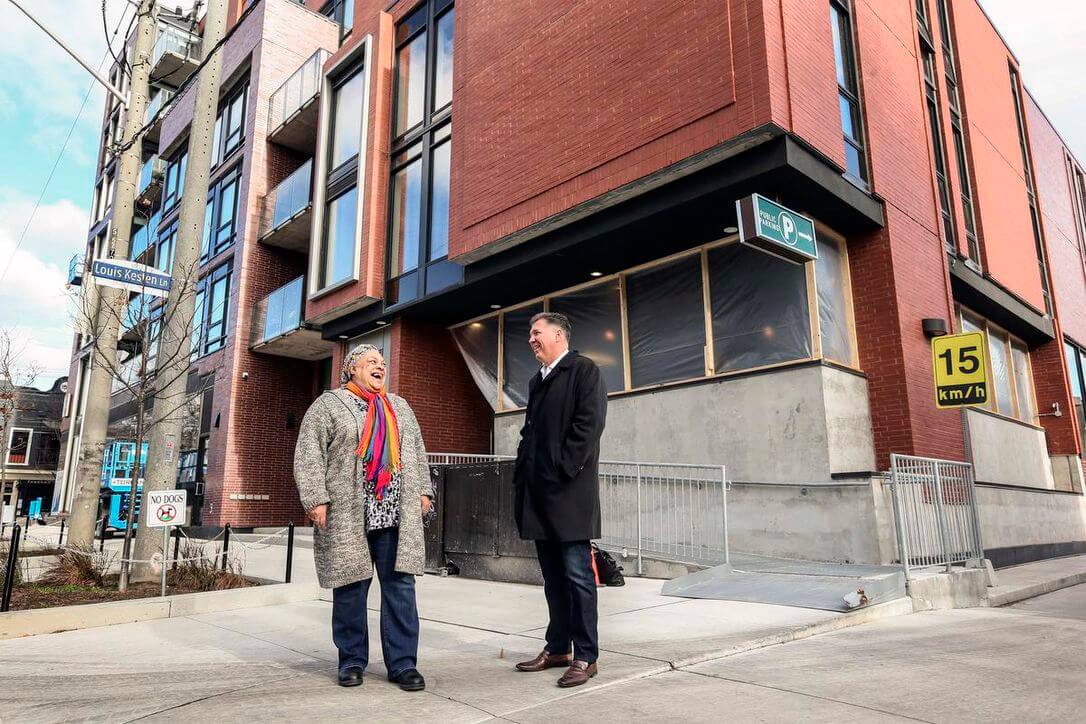“When all the parts come together it’s magic”: Condo developer and city offer refuge to Red Door shelter

For developer Chris Harhay his first memory of the old Red Door shelter plays back like a TV commercial.
He was a touring a property formerly owned by the United Church at Queen Street East and Logan Avenue in 2016 with an eye to building condos in what was then the Red Door’s quarters.
“A little kid comes out with a stuffed bear, and I looked around at the conditions of the shelter and they were less than favourable,” said Harhay. “It was in disrepair and it just pulled at your heart strings.”
He immediately thought: “I could build a great shelter for these people at less cost than the city. Here’s an opportunity to do something great.”
In the end, Harhay Developments built 122 condos above streetfront retail space.
But, in a rare confluence of civic flexibility, creativity and goodwill, a new Red Door shelter has also been incorporated in the site.
It is among the most dramatic examples of mixed-use development that combines private sector real estate with public uses – something the Toronto region has, with little fanfare, built more and better than most cities around the globe, according to Matti Siemiatycki, interim director of the School of Cities at the University of Toronto.
It is a real estate trend that he said will be critical in post-pandemic city building to incorporate community hubs, affordable housing, libraries and schools close to homes and jobs.
“There must be 50 of these projects and almost no one knows about them,” said Siemiatycki.
Originally Harhay Developments was going to own the entire site. But in the end the city bought the shelter, leasing it back to the Red Door for $1 a year, said Coun. Paula Fletcher (Ward 14, Toronto-Danforth), who championed the arrangement, believed to be the first in Toronto to incorporate a shelter into a private residential development.
“It really was people working together and trying to come up with the best outcome. The developer got his condos and the condos get their (stores) and we get the shelter,” said Red Door executive director Carol Latchford.
The shelter, which has been in temporary quarters during construction, expects to occupy its new building early in 2021.
The community petitioned in favour of saving the shelter, which was in danger of becoming homeless when the old church property was sold. That community now includes the condo residents.
“The people that are in the condo are very excited to be part of this community. They look at it as a piece of Leslieville community,” said Latchford.
None of the condo buyers ever expressed any concern about the shared proximity, said Harhay.
“These community services are embedded in our urban fabric downtown. I think it is something people understand,” he said.
To encourage more such collaborations, the School of Cities has a Creative Mixed-Use Building Initiative that is building a matchmaking platform to help public, non-profit and private sector users identify mutually beneficial real estate opportunities and then teach them about what the other partner needs to be successful.
“Between the private and the non-profit – each has different ways of doing things and each has different ways they measure and understand success,” said Siemiatycki.
The Red Door is a dramatic example of mixed civic and private-use development. The School of Cities has compiled a list of dozens more ranging from daycares in condos to Ryerson University’s athletic facilities and Loblaws co-habiting the old Maple Leaf Gardens; the Canadian Tire store at Ryerson’s Ted Rogers School of Management; the Streetcar Crowsnest theatre and arts space in a condo building.
Most of these have happened organically as one-offs, said Siemiatycki. “They’re often negotiated and sometimes these negotiations are protracted and complicated. It really has been a way of solving very localized, often site-specific problems.”
“If it brings together different end uses into the same building envelope, it enables them to achieve a collaborative advantage, an outcome that is better than what any of them can achieve on their own,” he said.
Shared public and private-use development isn’t the norm because most builders are in business to make money, but sometimes the city can leverage zoning, height permissions and other approvals to make the economics work for everyone, said Fletcher.
“When all the parts come together it’s magic,” she said.
“If you have something that requires (builders) to be more thoughtful about the property to enable them to build what they want, that would be great,” said Fletcher.
For developers the economics have to make sense, said Harhay.
The Red Door is a separate building from the retail and condo occupants on the site, but all three parties will share a loading dock and some of the mechanicals such as fire alarms.
As Toronto’s development industry matures, developers are recognizing the long-term impact of their buildings on the city and the community, said Harhay.
“For me that was a driving factor. This is my chance to do something that I can give back to the community that I’m part of and my buildings are part of,” he said.
The Red Door provides refuge for between 300 and 400 families a year. The only clients it doesn’t accept are single men.
Families, who stay an average of three months, occupy a suite with a bedroom and bathroom. If it’s a large family, the suites can be opened to the adjoining rooms.
Private donations have helped outfit parts of the new facility, said Latchford.
Harhay said he remembers the old shelter was dim and institutional. Now, he said, families at the Red Door will have big windows and bright rooms.
“We’ve got condo-level finishes,” he said. “The tiles in the washrooms and the faucets and sinks are the same as the condo next door.”